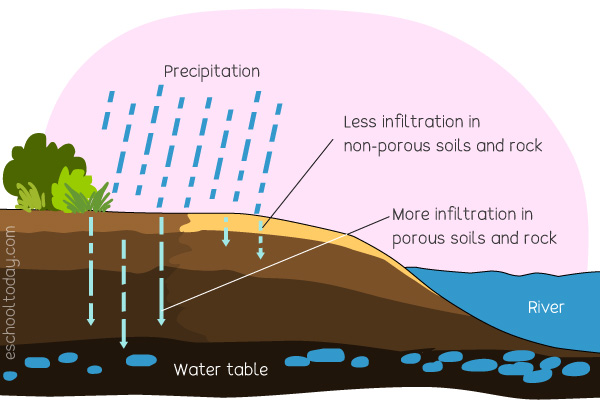- The Water Cycle
What is infiltration the water cycle?
Infiltration is the process by which precipitation or water soaks into subsurface soils and moves into rocks through cracks and pore spaces. As we mentioned before, the bulk of rainwater and melted snow end up infiltrated.
But where does it go in the ground?
Water may get absorbed by the soil and may stay in the soil for a long time until it gradually gets evaporated. If there is a lot of vegetative covers (green plants), the infiltrated water can also get absorbed by plant roots and later transpired. Infiltration occurs in the upper layers of the ground but may also continue further downwards into the water table.

Depending on how saturated the ground is, the water can continue downwards to replenish water tables and aquifers. This is called percolation. If there are water bodies nearby, the infiltrated water can also end up in the water bodies after.
The rate of infiltration depends on factors such as, the amount of precipitation, the type of soils, the amount of vegetative cover over the area, pre-saturation levels, the topography of the land, as well as the levels of evapotranspiration in that region.
Our research for this topic included these sources:
sss1. The USGS Water Science School. wwww.ga.water.usgs.gov/edu/watercyclesummary.html#evapotranspiration)
2. National Weather Service, Columbia SC. www.erh.noaa.gov/cae/svrwx/hail.htm
3. Michigan Environmental Education Curriculum. The Watershed Concept. www.techalive.mtu.edu/meec/module01/Infiltration.htm
4. The Weather Notebook. Chinook Melt, http://www.weathernotebook.org/transcripts/2001/03/14.html
5. THE WATER CYCLE: A GUIDE FOR STUDENTS: www.freedrinkingwater.com/resource-water-cycle-student-guide.htm
6. FWR, Hydrological cycle. www.euwfd.com/html/hydrological_cycle.html
7. Kids Konnect. Clouds. www.kidskonnect.com/subjectindex/15-educational/science/67-clouds.html
